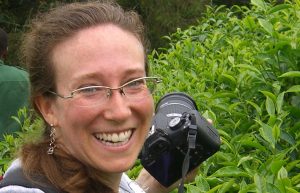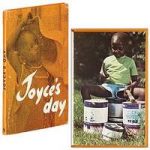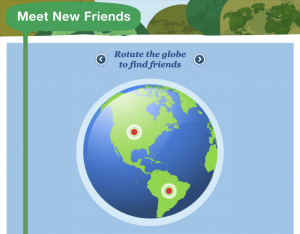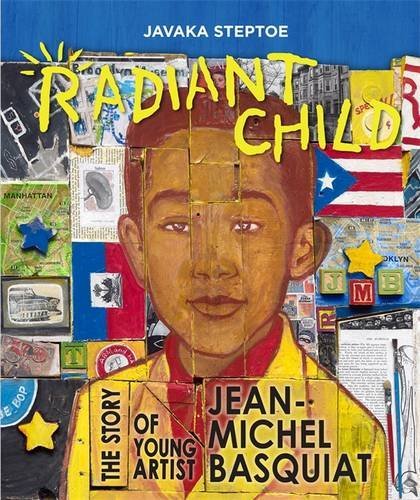This partial transcript of the App Fairy podcast has been edited for length and clarity. Please listen to the full episode here, and visit appfairy.org for more information about One Globe Kids.
Carissa Christner: Welcome to the App Fairy podcast, where I, Carissa Christner, the App Fairy, introduce you to some of my very favorite app developers.
This is our first episode, so I wanted to tell you a little bit about why I decided to create this podcast. I’m a children’s librarian, and a few years ago I started using apps in my story time and at my library in general, but when I was trying to find good apps to use at my library, it was a real challenge. There are a lot of apps in the App Store and the App Store itself can be kind of hard to navigate and it can be really hard to find stuff that you really love.
So I started looking and testing out apps… and over the years, I’ve discovered that I have a few favorite app developers. It’s sort of like when you go into a library or a bookstore and there are tons and tons of books on the shelves. If I didn’t know any authors then going and looking at all those shelves would feel extremely, extremely overwhelming. So when I go into the app store, if I don’t know any app developers, it’s the same thing. But now that I have some favorite authors that I like, whenever I know that a new book is going to be coming out by them, I get super excited. And I get that same giddy sense of anticipation whenever I learn that my favorite app developers are going to be putting out a new app.
I wanted to introduce you to some of my favorites, so that perhaps you can also feel that sense of happiness when you learn that they are putting out a new app, or when you discover something new by them. Today I’m excited to introduce you to Anne Glick, creator of One Globe Kids, an app that lets users virtually meet new friends from around the world.
The story of Valdo from Haiti comes free with the app and you can follow him in pictures through a typical day and hear him talk about his life.
“My name is Valdo. Our home is in mountains. Come, I’ll show you around!”
Through an in-app purchase you can also meet a girl named Gabou who is from Haiti and hear about her day.
“My name is Gabou.”
There are also children from the Netherlands, Indonesia, Burundi, and New York City. [The app] does a great job of including a thoughtful mix of both boys and girls, children from different races and from different socio economic backgrounds… I’m really glad you’re able to talk with us today, Anne. Tell us a little bit more about your app, One Globe Kids.

Anne Glick: One Globe Kids is a collection of global friends. It’s designed for children from 4 to 10 years old. Through it, children can have the experience of meeting and spending time with, being a friend with, somebody from someplace they’ve never been. Maybe someone who speaks a different language, has a different religion, or comes from a different culture. And it’s designed to be visually and audio-ly rich enough so that it’s like a friendship experience.
CC: Anne, I’m wondering if you wouldn’t mind backing up and telling everyone the story of why you created One Globe Kids.
AG: Definitely. I think it was a convergence of a number of things that happened. I was reading with my three-year-old, who was fascinated with books that just had pictures and letters in them. At first I was like, oh my gosh, these are so boring. But he just loved them.

And then… I found a book that an aunt gave to me years ago, I think when I was born, but I didn’t discover it until I was probably five. And it’s this book called “Joyce’s Day.” It was published in South Africa, and it’s really simple but it’s a photo of a little girl called Joyce. She goes shopping with her mom, and she has breakfast with her brother, and they play outside. I read it to my son, Sebastian, and it just brought back all these memories of how much I loved that book. I was fascinated when I was little—she would carry her doll on her back wrapped up with a towel, and her mom carried the groceries home on her head—I found it fascinating. They were the same as me, but a little different. And Sebastian reacted the same way. Not so much to Joyce but to her brother Babu, who builds a car out of wire and makes his own drums and stuff like that. And around that same time, some friends of mine in New York—we were mom friends and we all had young kids and they would say, “Oh, it’s cool that your kids get to travel (because we come to the Netherlands sometimes because of my husband’s family and we’re raising the kids to also speak Dutch.)” And they’d say “I wish that I could do that kind of thing for my kids.” There was the idea that there was more to life than just where we were living in New York City, and they wanted to introduce that to their kids.
CC: So that’s kind of the concept…
AG: Yeah. And I started thinking, this is what I really love—I really love living abroad and trying to explain what goes on in my life overseas, and how it’s so similar to what’s happening back home when I come to Wisconsin. So I thought, maybe I’m going to try and do that. So I went to Haiti for for another development-related job and I stayed with Valdo and Gabou. [CC: The first two kids featured in your app…]
I had arranged it all ahead of time. But originally I thought I was making a book series like the Joyce’s Day book. But soon after I came back a few months later, the earthquake hit in Port au Prince. And I had all these images in my mind of what happened there and how when I was there, I did all sorts of fun things with these kids. And after making sure that everybody was safe, I realized it. I didn’t want the story to only be about how everybody in Haiti was wounded and poor, because they’re also just like us. And that’s the message I want my kids to have. And about the same time, the iPhone hit the market in New York, and I saw a mom at a playground, and they were trying to get home and she’d handed her phone to her child. I was a little bit surprised by it, but I started to see it more and more, and I thought actually, this could be a good way to make something that’s really engaging and that can be shared really widely.
…
CC: Right. So you went to Haiti and you did the photography when you thought it was going to be a book. How did the project continue to grow to include the other kids?
AG: When I started I had no idea what a journey it would be. I made the first app and even just making the Valdo and Gabou story into apps was an adventure. I was living in New York City and I really enjoy languages, and one thing I like about technology and using apps and a set of books with it was how easy it was to create an experience where the child felt like they were really meeting the kids. But I didn’t want just English speaking children to be able to meet Valdo. So I looked for children who could read the stories in English and French and Dutch, which meant I was meeting all these kids in New York.
CC: Very international kids.

AG: Yes. That was a cool experience. And from there I realized, I don’t want it to be, not just us learning about them, it has to be a global thing. It’s not about the north or the south or the east or the west or the haves or the have-nots. It should be about everyone, because that’s the point—we all have so much in common. So I started thinking about which stories I could do next. And I found contacts in New York who I thought were representative of the area… New York, I guess because it’s so large, is the only city I’ve done so far.
In the Netherlands, I was able to feature children who lived in different areas of the country. And then I added Indonesia because I wanted to have more, someone from another region.
It’s not an audition—these are supposed to be normal kids. And that’s what I think the beauty of it is, because every normal kid is interesting and does cool stuff.
CC: So you travel to all these different locations and you do all the photography and interviews. I think that’s totally fascinating. How long do you spend at a location with a family?
AG: For each story I plan on a minimum of two days that I’m actually taking photos with each family. But it can be up to four. And then also a day before that, where you know, I’ve made all the contacts and connections prior to going, but I like to go and meet the family, and I don’t take any pictures. It’s just time to talk and make sure that they’re comfortable, and for me to meet the child and for the child to decide on their own that they want to participate.
I let the kids play with the camera. Because I’m going to be with them for several days—we have to get along. And I try to minimize as much as possible how my presence influences the images that I take of what their day is like.
CC: So that you’re really capturing a typical day in the life. Right.
AG: I try to blend in as much as possible.
CC: Yeah, I really like how you say that you make sure that the kid has buy-in too, because that’s really important. I mean, all these grown ups making decisions for them but they’re the ones who are the focus of it. So I really like that you are respecting the kids and letting them make the final decision about, “Yeah, I want to participate,”or “No, thanks.” It’s their story right right. Were most of the kids really excited?
AG: They’re a little bit nervous the first time I come because they don’t really know what it means. And with the Haiti stories, those kids really took a leap of faith because I didn’t have anything else to show them as an example. Then when I met the other children, you know, I could show them what it would be like. We would also talk a little bit about things that they like to do. I really find everything fun and interesting, so I can really show my enthusiasm that way and the kids are generally really enthusiastic too.
CC: I like watching you interact with kids. You’ve got a nice way with kids, which I think comes across in the app. I think it’s kind of important for the kids to feel like they’re talking to another kid, which is kind of the point of the app right?
AG: That’s absolutely the point of it. And I try to frame all images so that as much as possible they’re in the perspective of the child—you see how they’re experiencing something. The other thing I pay attention to when I’m taking pictures is what’s in the background and how the picture is framed. So every location is a little bit different. In Haiti they’re very wary of foreigners, you know, taking pictures of what they feel like is their poverty or showing that side of it. That is not my intention at all. My story is about Valdo and Gabou’s lives. So I am very intentional about how I frame the pictures, so that it is clear not only to the child but to anybody in the vicinity that this is a personal story.
CC: So Anne, one of the reasons that you developed this app is that you really wanted to encourage kids to embrace empathy when they think about kids from around the world. Can you tell us more about why that’s so important to you?
AG: There’s a lot of research starting to come out now talking about this, talking about the power images to reduce violence and increase cultural openness. And along with that, there’s the power of our imagination. There’s a new field called imagined contact and it’s part of the broader field of intergroup contact, which is about how people from different groups get along.
They know from research that it’s basically between the ages of seven to 10-years-old that implicit bias starts to settle in. So the research that’s come out on imagined contact for kids can potentially be immensely powerful for future generations. Imagined contact is when, instead of actually interacting with somebody, you can imagine yourself interacting with them, and researchers have been able to measure the benefits of that practice. It’s improved attitudes towards people in other groups—and it’s that perception of similarities with other groups that appears to have increased willingness for contact. They did [some studies] in Italy and the U.K. having schoolchildren imagine interacting with an immigrant child. And simply imagining playing with somebody was found to significantly increase their willingness to interact with them afterwards, when asked questions like, how likely are you to ask [an immigrant child at the playground] to play, to ask if they want to come over to your house, to ask them if they want to have dinner with your family, etc.
CC: Interesting. So if they imagined getting over that first hurdle of shyness, of not wanting to approach someone that seemed unfamiliar, if they just imagined that, it helped them to be more open to actually experiencing it?
AG: Yeah. And one of the reasons they think this works is because it helps you to create a mental script for yourself, which is actually something else I’m excited about. We’ve reached out to a number of researchers in this area. And Globe Smart Kids, the organization that’s making these apps, is going to be partnering with the University of Kent in a whole new field of study on using virtual contact through the app to create global systems and tackle prejudice. They call it simulated contact. So it’s basically, you know, a step beyond imagined contact—what our app is trying to do is give kids the feeling that they’ve already made a friend. They already are friends with Jenissa in Burundi, or Aji in Indonesia, so when they have the chance to be friends with somebody from somewhere else in their own environment, because they’ve already done it, it’s easy. It removes a lot of the anxiety and other hurdles that can get in the way of friendship with people from other groups that you maybe wouldn’t naturally choose to be friends with because you don’t perceive your similarities as easily.
CC: Wow. So your app could have some really far-reaching potential, and the theories behind it are really strong. And it’s fun! Are you planning to create any more recordings or are there any other kids that you’re thinking about featuring? What places are you planning to take us next?
AG: We have a number of places in production that I’m really excited about. We have stories from Israel and Palestine. And Norway, and another story from Indonesia. And the next places we’re looking at are South-America and China.
…
CC: I want to give a big thanks to Anne Glick for talking with us today. You can find more information, including a free printable activity for kids made by Anne exclusively for the App Fairy, on our website, appfairy.org.


